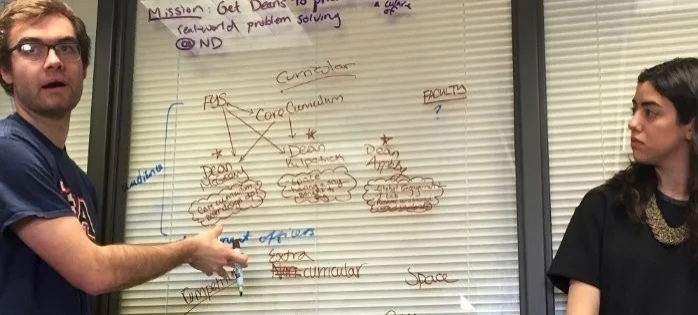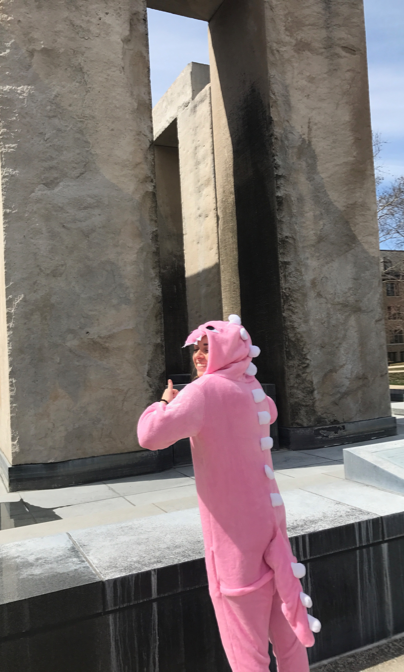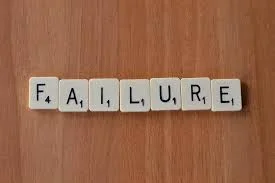I’ve had my share of failures:bad tests, cringe-worthy interviews, and failing to overcome hurdles (literally, as I plummeted to the ground face-first not once, but twice in my first hurdle race). While many focus on the topic of avoiding or learning from “failure,” what is often overlooked is the paralyzing effects of the fear of failure itself.
Learning to translate failures to success is critical but to begin, one must first overcome the barrier of fear by daring to fail.When my group and I were asked to “co-create” and teach a class on a “design-thinking” topic, we looked to the problem-solving process for inspiration and realized that the common thread that united all challenges was this fear to failure. Using this concept, our presentation took shape around two key questions:
1. Why and how should one dare to fail?
2. How can one evolve from failure towards success?
We looked at failure through a new lens: viewing the doubt and anxiety attached to the “fear of failure” as powerful motivators rather than inhibitions. After reframing failure as a foundation for change and preface for success, we encouraged our classmates to approach failure unconventionally—looking at it not as an outcome, but as skill to be practiced and developed.
We challenged our classmates to test this method and asked them to attempt to complete a set of 10 “rejection therapy” cards, each detailing a small task or action that essentially setting them up to “practice failure”:
Ask your roommate to pick out your outfit for a day
Ask the Starbucks barista to let you make a drink
Ask NDSP, the campus police force, for a ride to class
Ask someone on a lunch date or friendship date
Ask 5 strangers to tie your shoes
Ask (anybody) to give you a tour of The Huddle (the small campus grocery store)
Go to a club meeting that you’ve never been to before-challenge yourself to participate (even if you have no idea what’s going on)
Ask to audit a class with a topic you’re interested in or know nothing about
Ask to stay for free at the Morris Inn
Try to arrange a meeting with the University President—Fr. John Jenkins, CSC
Co-teaching on a topic as salient as failure naturally led to an intriguing and interactive class discussion in which I saw my own topic from new angles. However, the challenge remained: could I practice what I preached?—Could I constrain my fear of failure through the process of actively failing and could I draw insights from this process?
Challenge #1: To start my journey into failure, I chose the task that I knew would spark an eager and ruthless response—ask your roommate to pick out your outfit for a day. The result was as follows:
While my outfit did prompt some questioning and concerned stares, the “failure” of my pink dinosaur onesie to fit within social norms had the unexpected benefit of instigating conversations around the fear of failure. As my outfit prompted many “why’s” throughout the day, I was given a platform to expand on the discussion that had started in my co-taught class, gauging my peers’ opinions on the validity of “practicing failure” in an environment where there is little margin for error.
Challenge #2: Daring to fail requires vulnerability—a feeling I experienced first-hand as a long-line of customers tuned in as I, still dressed in my pink onesie, asked the Starbucks barista if I could “make my own drink.” As expected, my request prompted a series of negotiations where I proceeded to acknowledge the abnormality of my question and attempted to appease the barista’s apprehensions by offering to make the simplest drink possible. I then asked to talk to the manager who ultimately shot down my request.
My immediate reaction was the all-too-familiar sinking feeling—the one you get when you open a rejection email or realize you’ve slept through your alarm. However, as I reflected on the absurdity of my request, the sinking feeling was replaced with a sense of amusement as I began to brainstorm what I could’ve tried or accounted for in order to turn the “no” into a “yes.” Perhaps I could’ve succeeded if I’d visited Starbucks right before they closed or maybe I could’ve painted a clearer picture of the simplicity of my request by naming a specific easy-to-make drink like an “ice water.” I also began to notice that requesting a service from a stranger is much harder to swing than from a friend and realized that if I re-designed the process of trying to make my own drink such as trying to do so at a local coffee shop, I potentially could have a greater impact. Even though I approached the challenge with the intention of avoiding failure, I could not have drawn the same insights without poignantly experiencing the failure myself.
Challenge #3: After developing some inertia from the Starbucks challenge, I resolved to tackle another intimidating task—asking NDSP for a ride to class. However, my approach was something I should have learned not to do by now: I tried to take the path of least resistance. I decided to go with a simple backstory, that I had walked on my ankle weird, and a simple request, a ride to the University health center. Little did I know that 1. The health center was closed and 2. Apparently NDSP must send a whole medical team when someone reports an injury. After practicing my fake limp for an embarrassingly long amount of time and rehearsing the phone call, everything was derailed when the NDSP officer announced a medical team would come assist me shortly and I had to quite awkwardly apologize as I was unfortunately locked into my story.
Despite the uncomfortable encounter, I gained a valuable takeaway: you can’t plan for everything and telling the truth from the start is the only way to position yourself to be able to adjust to setbacks or rejections. I also realized that underneath my retreat to the “path of least resistance” was ironically the fear of failure I was working to overcome. The fear of failure not only manifests itself through inaction but can inadvertently influence people to take trivial or adverse actions that fail to attack the root of problems. Subconsciously, my desire to “complete” the task had overshadowed the underlying intention of “practicing failure” well by negotiating my way to a success.
Challenge #4: After surviving the rigor of the first few challenges, I decided to ramp up the stakes of my next one—asking someone on a friendship date. First, I challenged myself to ask a friend I knew on a surface level but wanted to get to know further. Second, I designed and sent my friend, Frankie, a formal “Evite” in an effort to deviate as far as I could from the norm of lunch invitations.
Luckily, Frankie happily obliged and the “weirdness” of my Evite naturally directed our lunch conversation towards the culture around failure and how we, as students, could encourage “practicing failure” or daring to fail outside of the high-stakes context of tests or responsibilities.
We realized that on top of practicing this vulnerability of failure, doing so in a collaborative manner that engages the community around us will help shape a culture of generative failure—where people feel free to voice their fears but simultaneously are challenged to use these fears of failure in a constructive way that informs the process of how one reaches a goal. In attempts to create a sustainable method of practicing failure, I passed my “rejection therapy” card along to Frankie and challenged him to complete the task and keep the conversation going.
Taking a step back to reflect on my trial run of “rejection therapy” as a whole, I realized I could group the challenges into two categories. The first were more micro-level challenges that required me to request something of an independent individual—my roommate or classmate. The second were macro-level challenges that pushed me to request something of an unknown individual, tied to a larger organization—a Starbucks barista and NDSP officer.
While I found myself more afraid of failure during the macro-level challenges, the practice of failing actually led me to draw more insights than when I “succeeded.” The act of failing can be discouraging, but when you openly address the possibility of failure and transcend this fear through action, it suddenly becomes an exciting starting point; failure triggers unexpected insights and can even introduce a new angle from which to view the problem.
Overall, practicing failure was a generative and arguably contagious process. Each challenge I undertook sparked discussions which translated into new ideas which informed the process of how I approached the next challenge. This idea of continual growth connects back to the nature of the fluid, interpersonal, and ongoing learning process of “co-teaching.” The insights I drew from practicing failure may be radically different than someone else who completes a parallel task. My hope is that the process of learning from failure itself will inspire others to do the same—extracting their own insights from their journey.







